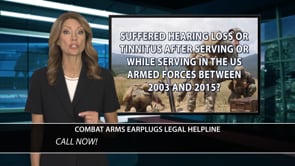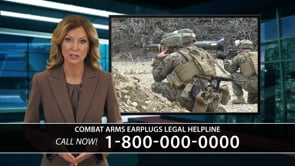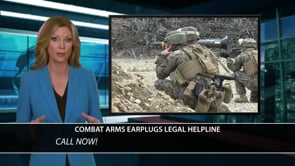Litigating Cases Against 3M's Defective Earplugs
- Effectiveness of 3M and Other Earplugs
- Types of Earplugs and Ear Protection
- The Different Types of 3M Earplugs and Ear Protection Products
- 3M Dual-Ended Combat Arms Earplugs Discontinued
- Why 3M Discontinued the Dual-Ended Combat Arms Earplugs
- Is hearing damage suffered after using 3M’s faulty earplugs irreversible?
- Treatment Options for Tinnitus
- Current Status of 3M Earplug Lawsuits
- CAMG Helps Law Firms Litigate 3M Earplug Cases
- TV Commercials
- Infomercials
- Landing Pages
- Social Media Campaigns
Noise-induced hearing loss is a prevalent threat to the health of individuals across the globe. The WHO (World Health Organization) estimates that 2.5 billion people will have some degree of hearing loss by 2050. The cause can vary, but most people who experience hearing loss can attribute their case to poor ear protection while listening to music, noisy work environments, or defective earplugs used in exceptionally loud conditions. Over-exposure to loud noise damages the ear tissues and can cause disabling hearing loss. According to WHO, a person is said to have a disabling hearing loss if the better hearing ear has a hearing loss of more than 35 decibels.
Music-related hearing loss accounts for approximately one billion cases among young adults. A JAMA Otolaryngology-Head & Neck Surgery study supports this finding, linking concerts and festivals to an increased risk of hearing loss or permanent damage.
According to the CDC (Centers for Disease Control and Prevention), approximately 25% of workers across all U.S. industries perform their duties in noisy environments, but only 66% of noise-exposed workers wear hearing protection.
Veterans and service members account for a large population of U.S. citizens who experience hearing loss due to service-related exposure. The Hearing Health Foundation reported over one million compensation recipients for hearing loss in 2017 alone.
Effectiveness of 3M and Other Earplugs
In 2016, JAMA Otolaryngology-Head & Neck Surgery did a study to test the effectiveness of earplugs in combating noise-induced hearing loss. The randomized clinical trial involved 51 participants attending a music concert. After dividing the participants into two groups, one group was given earplugs, while the other went in with no hearing protection. The study found that 42% of the participants without earplugs experienced temporary hearing loss after the noise exposure, compared to only 8% of the participants with earplugs. Furthermore, 40% of the unprotected participants experienced tinnitus (constant ringing in the ear), while only 12% of the protected group developed the same problem.
The study concludes that wearing hearing protection effectively reduces the chance of noise-induced hearing loss, as the rate of hearing complications was minimal in the group that had earplugs.
According to the CDC, over-exposure to noise above 70 decibels can start damaging your hearing, while any noise above 120 decibels can cause instant damage. The sound pressure from loud music ranges between 100 and 110 decibels, which correlates with the participants’ results in the JAMA Otolaryngology study.
In recent years, members of the military have been the focus of another form of noise-induced hearing loss. Faulty earplugs used during loud conflicts above 140 decibels were essentially defective, causing many service members permanent damage to their hearing. The earplugs, supplied by 3M, could not sufficiently block hazardous noise because the dual-ended earplug was too short to fit far enough into the ear.
Types of Earplugs and Ear Protection
Many people find earplugs effective at protecting their hearing during a variety of situations. Earplug types vary depending on their functionality. Some common uses include:
- Protecting ears from loud work environments, like military or construction
- Minimizing sound at music concerts and festivals
- Noise cancellation while studying
- Water protection while swimming or surfing
- Air pressure regulation while flying
- Reducing noise while sleeping
Earplugs also vary in material and strength of noise protection. Depending on the activity, switching from one form of earplugs to another is typically recommended.
Disposable Foam Earplugs
These are soft, expandable earplugs that roll into a thin cylinder before inserting into the ear. Once inside, they slowly expand to take the shape of the ear, thereby blocking any incoming sounds. These earplugs are ideal for noise reduction.
Pre-molded Reusable Earplugs
Reusable earplugs are made from plastic, silicone, or rubber and usually have a stem for easier insertion. They are available in several sizes to accommodate different ear shapes. The flanges usually seal the ear completely, making the earplugs ideal for blocking sounds or water.
Music Earplugs
Music earplugs have a unique design that reduces noise across a specific frequency range. The purpose is not to eliminate noise but to help filter the sound to reduce harmful volumes while maintaining good sound quality.
Flight Earplugs
During take-off and landing, the air pressure inside the cabin of an airplane can create uncomfortable pressure in the ear. Earplugs designed for flying can help alleviate this issue by slowing down the change in pressure.
Wax and Silicone Putty Earplugs
Wax earplugs help minimize sound by creating a seal against the ear canal. Silicon earplugs work similarly but are more effective at both minimizing noise and blocking out water while swimming.
Custom-molded Earplugs
As their name suggests, these earplugs use a custom mold to fit into the shape of an individual’s ear. An audiologist typically takes impressions of the ear canals to create the earplugs.
Earmuffs
Unlike earplugs that go into the ear, earmuffs block noise by covering the entire outer ear. While they may block most external noise, they are not ideal for people wearing glasses which create a gap in the seal around the outer ear.
The Different Types of 3M Earplugs and Ear Protection Products
3M’s most popular earplug is the Dual-Ended Combat Arms Earplugs, which are currently discontinued. These earplugs were the same type supplied to the Defense Logistics Agency for almost a decade. The dual-end plug features two sides, distinguished by their yellow and olive colors. Inserting the yellow side into the ear enabled soldiers to hear low volume sounds, like conversations between soldiers or commands from their officers. The olive side blocked loud noises such as gunshots.
3M also offers a variety of earplugs and ear protection products that range in design, size, and use. They are categorized by:
- Material type: Foam, thermoplastic, elastomeric polymer, polyurethane, and thermoplastic
- Design: Earmuff, bullet, cylinder, cone, bell, and flanged
- Decibel ranges: From 12 to 33 decibels
- Size: From small to large
- Insertion style: Roll, no roll, and push-to-fit
- Specialized features: Banded or corded
3M Dual-Ended Combat Arms Earplugs Discontinued
In 2003, 3M started supplying service members with the Dual-Ended Combat Arms Earplugs and was the exclusive supplier up to 2012. During that time, hundreds of thousands of soldiers used 3M’s earplugs and have since been diagnosed with hearing loss and tinnitus.
An investigation revealed that 3M was aware of this defect, even when signing the contract, violating the False Claims Act. The government initiated legal action against the company, earning a settlement of $9.1 million, but 3M did not admit fault. The company discontinued the product in 2015, though they never officially recalled it.
Why 3M Discontinued the Dual-Ended Combat Arms Earplugs
When signing the contract, 3M had rated their olive end of the plug at 22 decibels, while the yellow end’s noise reduction rating (NRR) was 0. These features were designed to protect soldiers from harmful sounds on the battlefield while also allowing them to communicate amongst themselves.
Following the exposure of a whistleblower, tests found that the earplugs had a faulty design. They were too short and could not fit properly into the ear. This defect reduced the NRR of the olive side to 10.9 and the yellow side to -2, subjecting the soldiers to extreme risk of hearing damage.
Is hearing damage suffered after using 3M's faulty earplugs irreversible?
Loud noise can cause temporary or permanent damage depending on the intensity and duration of exposure. Battlefield noises usually have very high sound pressure, over 140 decibels, which can cause instant hearing loss. The damage can be permanent when service members experience such noises for long durations without adequate hearing protection.
Unfortunately, the type of extreme damage sustained by military personnel using 3M’s earplugs is incurable. Most soldiers suffer from tinnitus, or constant ringing in the ear, which is an exceptionally frustrating version of hearing loss. This type of hearing damage is not reversible, but mitigating the effects can keep it from getting worse.
Some of the effects of tinnitus include:
- Distress
- Depression and anxiety
- Frequent mood swings, including irritability and frustration
- Poor concentration and sleep quality
Treatment Options for Tinnitus
Scientists are still working on a cure for tinnitus, so those suffering from this condition must rely on other treatments to help manage the symptoms. Some recommendations include:
Hearing Aids
Poor hearing quality affects the way the brain processes information, which can result in mental decline. However, quick intervention, such as hearing aids, can minimize the impact, enabling the patient to lead a quality life.
Sound Masking
Sound masking involves fitting a device in the ear that plays a counteractive noise, like white noise, to mask the perception of tinnitus. Unfortunately, the sound mask only helps neutralize the tinnitus noises and has no long-lasting effect.
Behavioral Therapy
This treatment involves using cognitive techniques to help the patient refocus their thinking and build coping skills. Though it does not alleviate tinnitus, the patient learns to manage their situation better, preventing worsening health.
Drug Therapy
As a patient struggles with tinnitus, their mental health can deteriorate, decreasing their quality of life. Administering antidepressants and antianxiety drugs can help manage these side effects.
Current Status of 3M Earplug Lawsuits
While the federal government was able to win their case with a settlement of $9.1 million, they used none of this money to compensate soldiers directly impacted by 3M’s faulty earplugs. As a result, veterans suffering from hearing loss and tinnitus are taking action against 3M in independent lawsuits.
An estimated 250,000 service members are suffering from hearing loss and tinnitus, making this the country’s most extensive multidistrict litigation. A federal judge in Florida ordered an expedited trial schedule to move thousands of cases forward to reduce the massive backlog of lawsuits against 3M.
Settlement discussions initially occurred in the fall of 2022 but did not result in a settlement. One of the primary factors in settling was 3M’s willingness to consider fair settlement amounts. In August 2023, a settlement was reached, announcing that 3M has agreed to pay $6 Billion to settle its lawsuit with U.S. veterans and service members. This settlement will help to resolve approximately 300,000 lawsuits that were filed against the company and its defective earplugs. With this, over 240,000 people are expected to be eligible for compensation.
Notable cases and settlements include the following plaintiffs:
Lewis Keefer, Luke Estes, and Stephen Hacker
In April 2021, Luke Estes, Lewis Keefer, and Stephen Hacker alleged the 3M earplugs had caused their hearing loss during active duty. A jury ruled in favor of the soldiers, earning them a combined settlement of $7.1 million.
Dustin McCombs
In May 2021, another suit was brought by veteran Dustin McCombs. In this case, the jury did not establish 3M’s liability, which was a loss for the veteran, resulting in no settlement. Following the verdict, 3M released a statement to Bloomberg Law stating, “We are pleased with today’s verdict and will continue to vigorously defend ourselves in upcoming trials.”
Lloyd Baker
In June 2021, veteran Lloyd Baker sued 3M for injury to his hearing sustained during his time as an infantryman and machine gun operator. The jury found 3M partially responsible, awarding Baker $1.7 million.
CAMG Helps Law Firms Litigate 3M Earplug Cases
At CAMG, we help law firms run mass tort campaigns to find clients needing legal representation. We know how to reach the right clients by crafting compelling messages, commercials, infomercials, landing pages, and social media campaigns.
From the outreach to handling case management tasks, we take the load off your shoulders so you can concentrate on doing what you know best; representing clients. If your firm is interested in litigating 3M earplug cases, contact us today.
TV Commercials
Infomercials
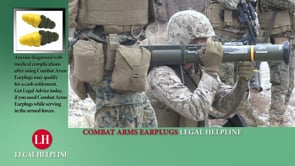
Landing Pages
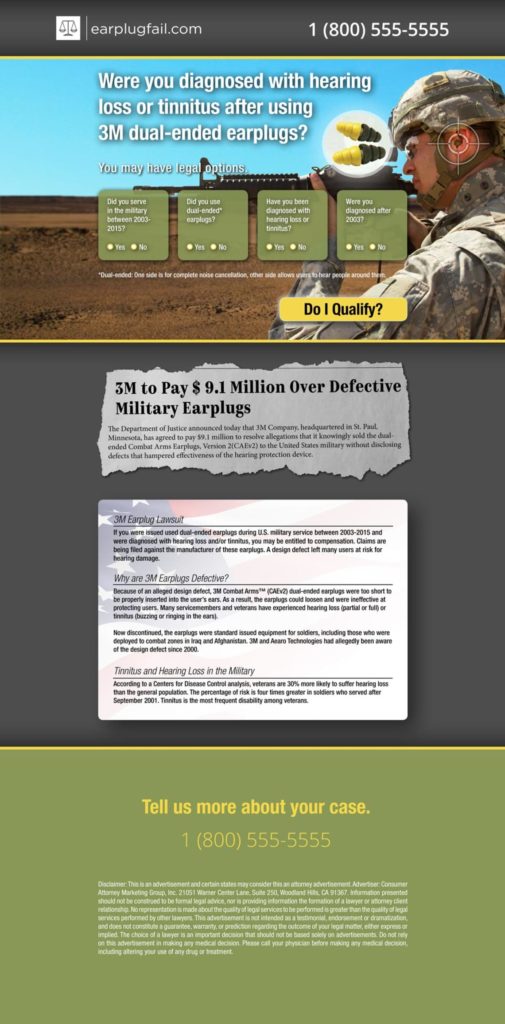
Social Media Campaigns
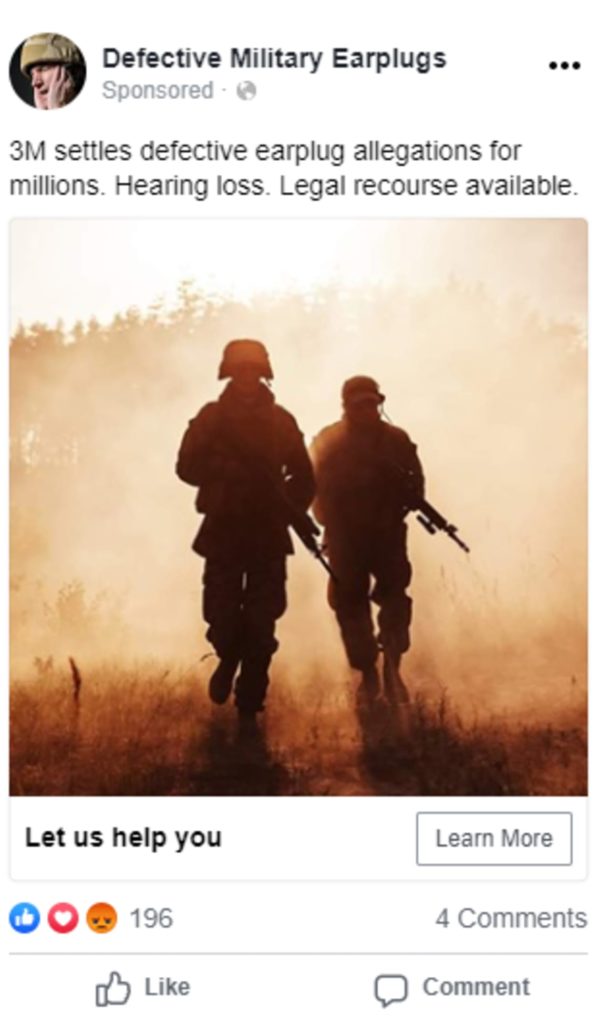
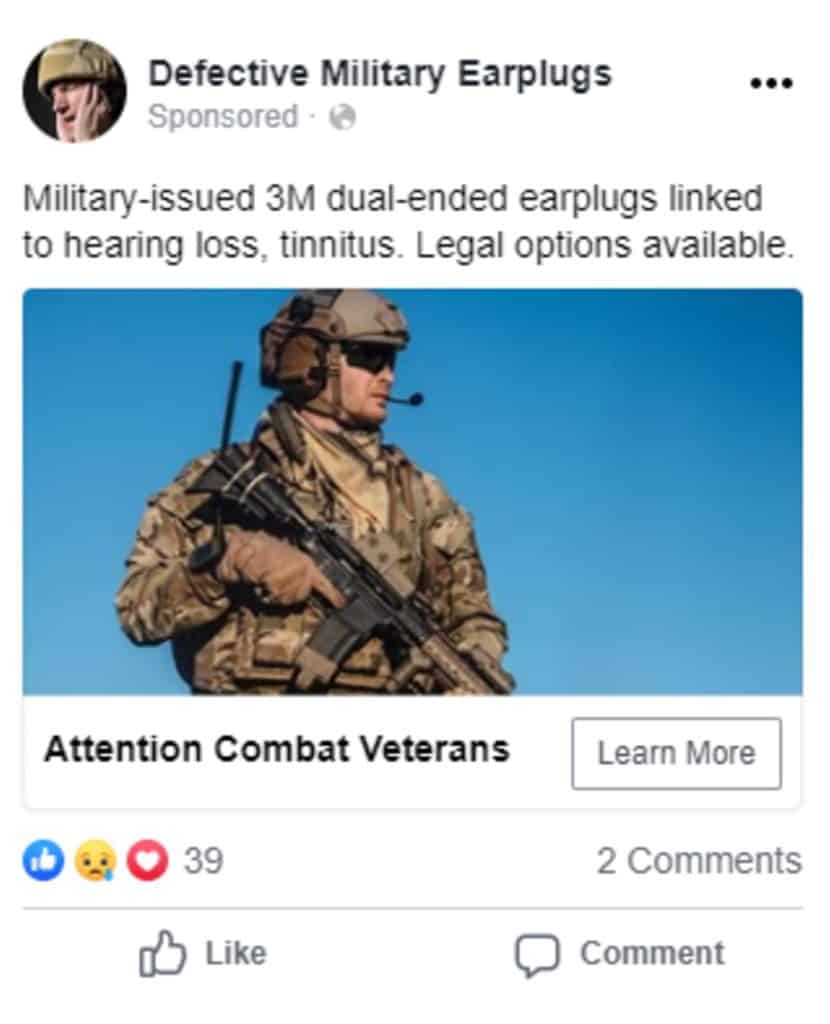
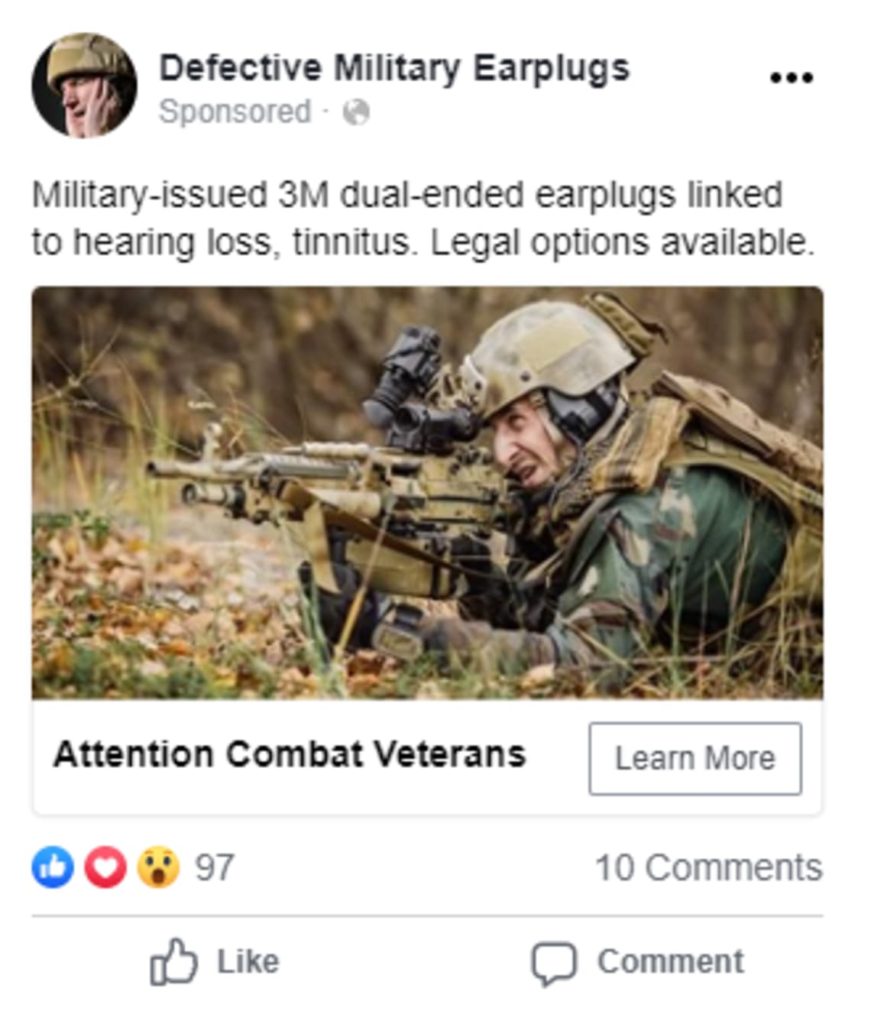
CAMG has thousands of spots and infomercials that can be branded for your firm. Reach out to us for the latest creative offline and online examples*.
*Examples shown are not always current examples.
Request Samples
* These fields are required.

Is your firm in the Top 3 of Google Search?

CAMG Ethics White Paper
Legal Areas
Are you looking for data-driven marketing for your law firm?
I have worked with CAMG for years. Not only are they great at delivering, but they are great people to work with!

CAMG is always accommodating and willing to work in a way that supports your office as an extension of your team.

Steve Nober and the team at CAMG are responsive, ethical, talented, reasonably priced, and easy to work with!

If you are looking for professional, hardworking people who produce great results and then take you out for a nice dinner, look no further than CAMG
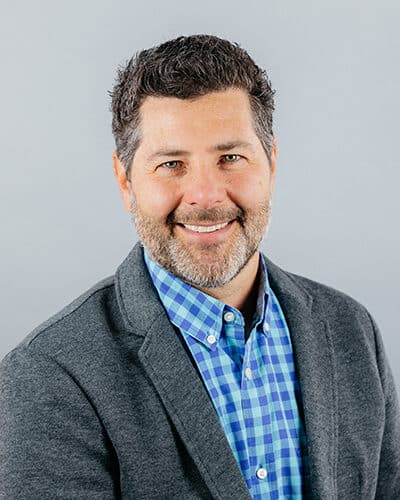
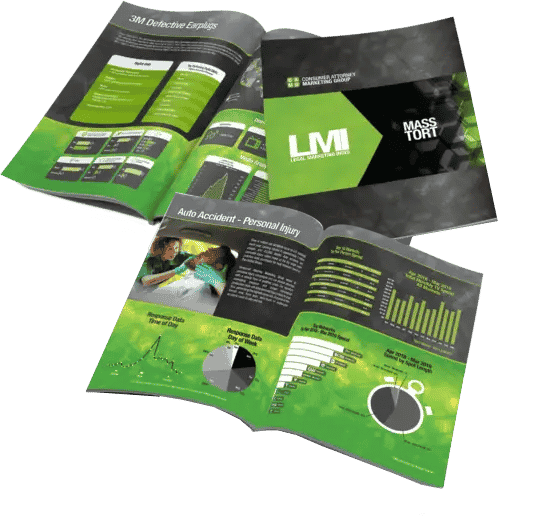
THE NATION’S LARGEST FULLY INTEGRATED
Marketing Agency Dedicated to Law Firms
- Television
- Radio
- Public Relations
- Medical Record Retrieval & Review
- Search Engine Optimization
- Paid Digital
- Out of Home
- Intake & Contracting Services

